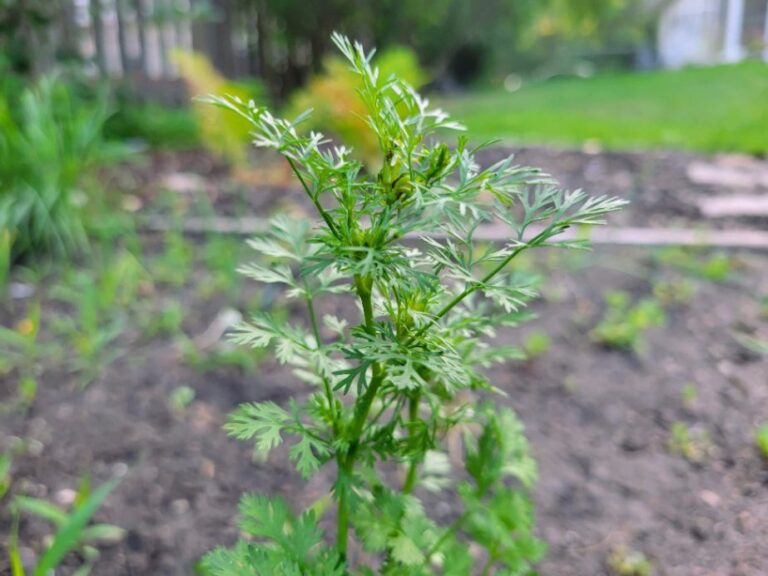This post may contain affiliate links which means I may receive a commission for purchases made through links. I only recommend products that I have personally used. As an Amazon Associate I earn from qualifying purchases. Learn more on my Private Policy page.

Home gardeners hold a special place in their hearts for cilantro, an aromatic herb celebrated for its distinct flavor. It is important to understand which plants are suitable for growing alongside cilantro in your garden and what should be avoided.
What grows well with cilantro?
Cilantro grows well with moisture-loving herbs like parsley, basil, and chives. It also helps to keep pests away from vegetables like cabbage, broccoli, kale, and potatoes. Cilantro benefits from being planted near beans, peas, tomatoes, peppers, and flowers like alyssum, zinnias, sunflowers, and marigolds.
Table of Contents
What Herbs Grow Well with Cilantro?
Cilantro thrives in moist soil conditions, making it an excellent garden companion to herbs with similar water needs, such as parsley, basil, and chives. I’ve found that planting these herbs near each other in the garden allows me to manage their watering requirements better.
Parsley and Cilantro

Parsley and cilantro require consistent moisture to thrive, making them excellent companions in the garden. Their water-loving nature ensures they receive adequate hydration without competing for resources, making cilantro a good companion to parsley.
Basil and Cilantro

Basil and cilantro are excellent companions in the herb garden, as they both prefer full sun exposure, well-draining soil, and regular moisture.
When companion planting basil with cilantro, ensure they are given enough space to avoid overcrowding. This will allow proper air circulation around the plants and reduce the risk of fungal diseases.
Chives and Cilantro

Chives, known for their mild onion-like flavor, are excellent cilantro companions. Chives and cilantro share a similar love for moisture and have comparable growing requirements.
When planting chives and cilantro together, ensure that they receive regular watering to keep the soil consistently moist. Provide them with adequate sunlight to encourage robust growth and enhance their flavors.
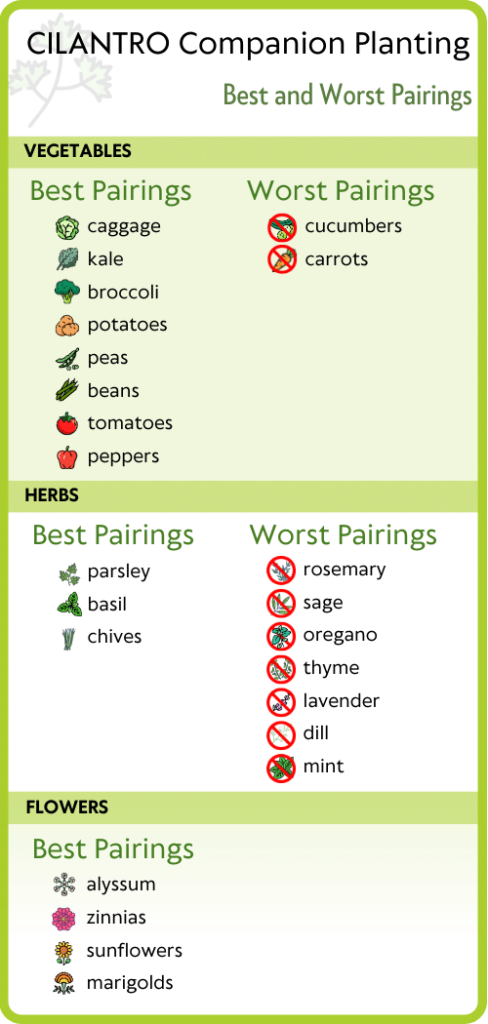
Brassicas and Cilantro
Brassicas like cabbage, kale, and broccoli can benefit from being planted near cilantro. A key benefit of planting cilantro near brassicas is its ability to repel common pests that affect them. The strong scent of cilantro deters harmful insects such as aphids, cabbage worms, and flea beetles. You create a natural barrier that discourages these pests from attacking by interplanting cilantro in your brassica vegetable crop.
Cabbage and Cilantro

Cilantro benefits cabbage by attracting beneficial insects such as lacewings and hoverflies, which naturally combat cabbage worms and other pests harmful to brassica plants. These insects feed on the eggs and larvae of unwanted pests, safeguarding your cabbage patch from these common garden pests.
Kale and Cilantro

Kale also benefits from a positive interaction with cilantro, which attracts parasitic wasps that target cabbage loopers, a common pest of kale leaves. Pairing these two plants fosters an environment where kale thrives and discourages undesirable pests.
Broccoli and Cilantro

Cilantro makes a good companion plant to broccoli as well. Cilantro’s fragrance lures beneficial insects like ladybugs and hoverflies, natural predators of common broccoli pests like aphids and caterpillars. These insects safeguard broccoli plants, promoting a healthier garden without excessive pesticides.
When planting cilantro with your brassica crops, ensure enough room to avoid overcrowding. Brassicas typically require ample space for proper growth, so give them enough room while allowing cilantro to be interspersed throughout the area.
Potatoes and Cilantro

Cilantro is a good companion to potatoes due to its natural ability to repel potato beetles. The Colorado potato beetle can rapidly devastate potato crops if not managed. Yet, cilantro’s potent scent keeps them away, reducing the risk of infestation.
Cultivating cilantro with potatoes boosts garden biodiversity, aiding in the prevention of disease and pest proliferation.
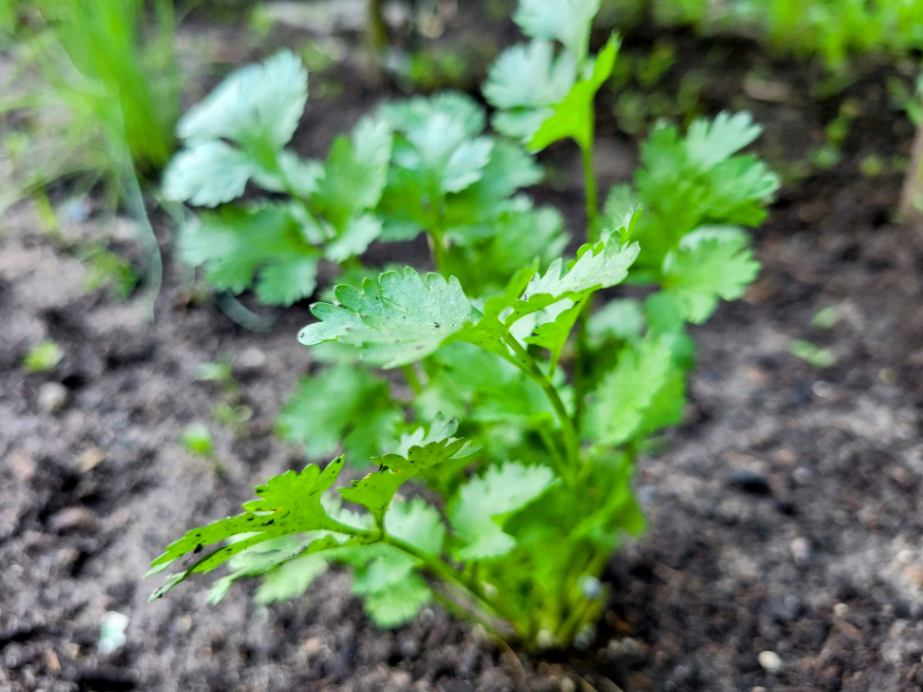
Beans and Peas as Cilantro Companions

Due to their nitrogen-fixing properties, beans and peas serve as excellent companion plants for cilantro. These legumes have a symbiotic relationship with rhizobia bacteria, enriching the soil by converting atmospheric nitrogen into a usable form. With its high nitrogen requirements, cilantro benefits from this nutrient boost provided by beans and peas, leading to healthier growth.

Moreover, cilantro and legumes share similar moisture preferences, ensuring consistent watering and overall garden harmony.
Companion planting cilantro with legumes also helps deter pests. Cilantro emits a strong aroma that repels certain insects, including beetles. By interplanting cilantro with beans or peas, you create a natural barrier that can help protect them.
Tomatoes and Peppers Shade Cilantro

Tomatoes and peppers are ideal garden companion plants for cilantro due to their shading benefits. Cilantro can bolt prematurely in excessive heat or sun. By planting tomatoes or peppers near cilantro, you create a natural canopy that provides shade for cilantro’s delicate leaves during scorching summer months.

This shading provided by peppers and tomatoes prevents cilantro from withering and bolting and maintains cooler temperatures around the herb, reducing stress caused by intense heat. Once cilantro has bolted and flowered, coriander seeds will begin to develop.
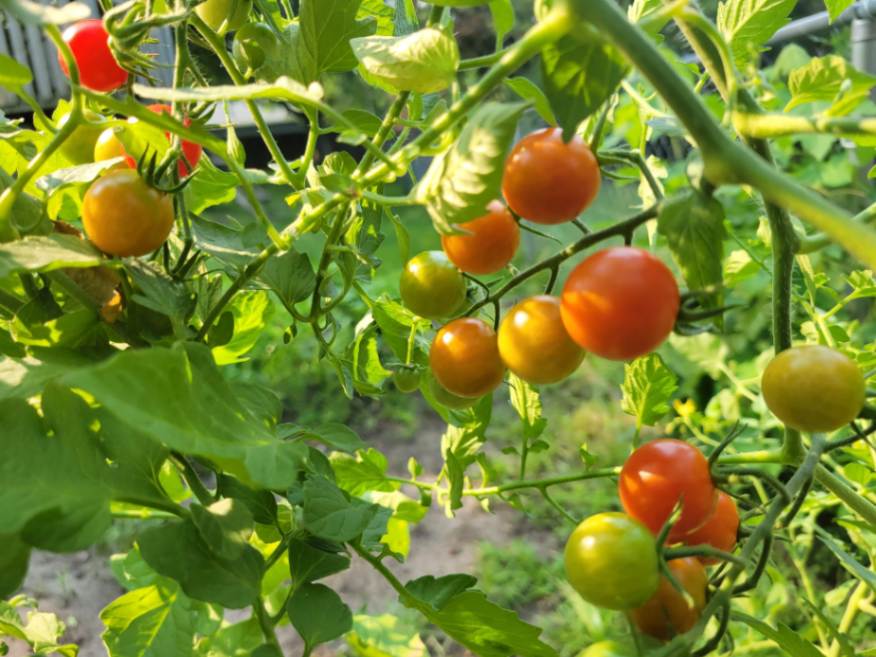
Beneficial Flowering Companions of Cilantro
Incorporating alyssum, zinnias, sunflowers, and marigolds into your garden can benefit your cilantro plants. These vibrant blooms add beauty to your garden landscape and attract beneficial insects that can help enhance the growth and health of your cilantro.
Alyssum and Cilantro

Alyssum is known for its sweet fragrance and small flowers that attract beneficial insects like hoverflies, lacewings, and parasitic wasps. These insects help to control garden pests by preying on aphids, caterpillars, and other harmful bugs. Cilantro attracts pollinators like bees and butterflies, which are crucial for the reproduction of many plants. Together, these plants can improve the overall health of your garden.
Zinnias and Cilantro

Zinnias and cilantro are often grown together due to zinnias’ ability to attract pollinators. Cilantro’s natural pest-repelling properties help shield zinnias from potential pest damage. This symbiotic relationship enhances the overall health and protection of both plants.
Sunflowers and Cilantro

Strategically placing sunflowers near cilantro patches provides a natural shield against pests. Sunflowers emit protective chemicals that deter harmful insects, creating a healthier environment for cilantro growth.
Marigolds and Cilantro

Marigolds release compounds that repel soil-dwelling pests, safeguarding cilantro’s root system. This partnership ensures vigorous above-ground cilantro growth and sustained leaf production, fostering plant health.
What Should You Not Plant Near Cilantro?
Cilantro’s specific moisture needs make it an unsuitable companion for several herbs and vegetables. Herbs such as rosemary, sage, oregano, thyme, and lavender have different moisture requirements and should not be planted alongside cilantro. Additionally, dill and mint are herbs that do not complement cilantro well in a garden setting.
Regarding vegetables, cucumbers and carrots also fall into the category of poor companions for cilantro due to their differing cultivation requirements.
See my article on What Not to Plant with Cilantro for more information.
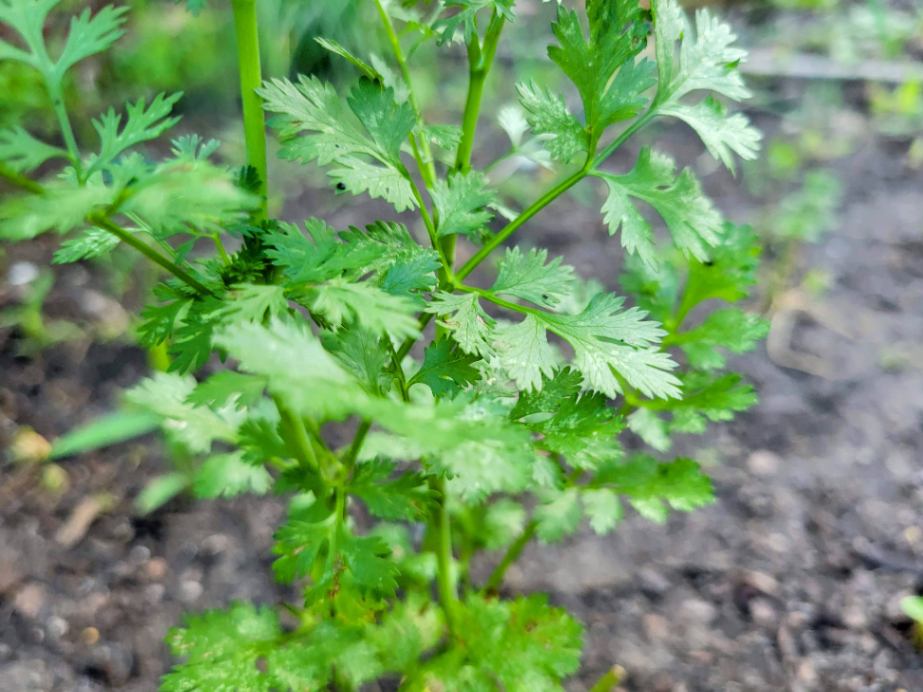
Frequently Asked Questions (FAQs)
Can I plant cilantro with tomatoes?
Tomatoes make great companion plants for cilantro in the garden. They provide beneficial shading that helps prevent cilantro from bolting prematurely during hot summer months. The natural canopy created by tomatoes also helps to reduce plant stress on cilantro from intense mid-summer heat.
How often should I water my cilantro plants?
Cilantro prefers consistently moist soil but not overly saturated conditions. Water deeply whenever the top inch of soil feels dry to the touch. Cilantro thrives when planted with herbs such as basil, parsley and chives that require regular watering.
Can I plant cilantro next to basil?
Cilantro and basil thrive when grown next to each other as they have similar growing requirements, including a preference for consistent moisture and rich, well-drained soil. Cilantro flourishes when planted alongside herbs such as chives and parsley with similar moisture and growing requirements.
Last Updated on 4 March 2024 by Bob Lee

